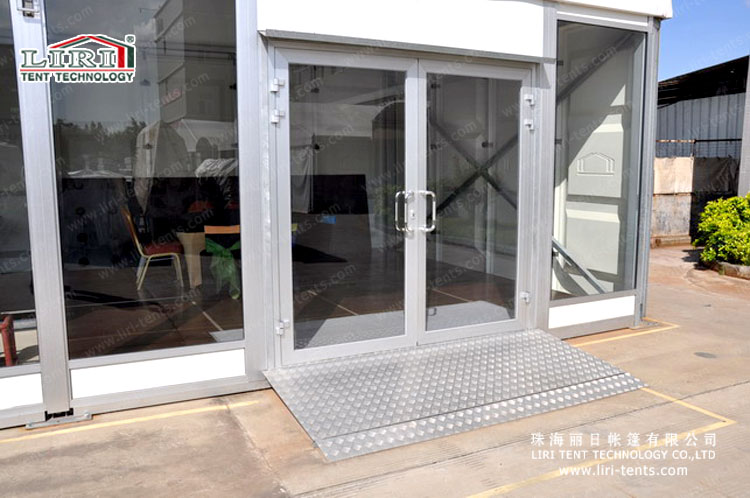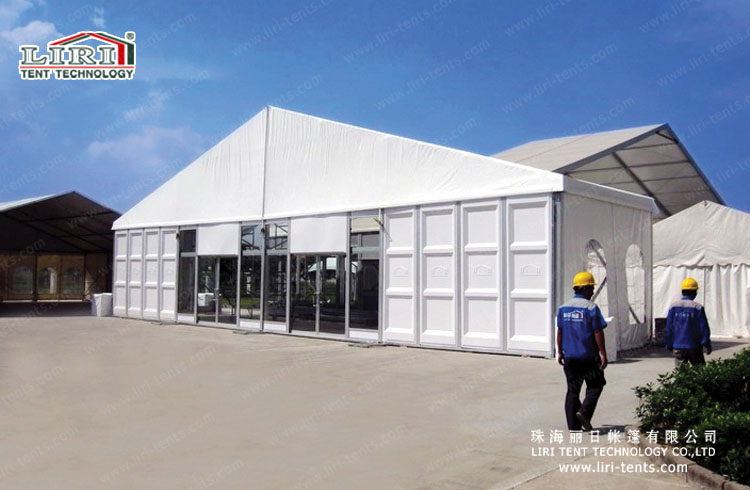Dress up your customer’s event with clear vinyl panels,glass sidewalls and double doors.
Accessories such as doors,clear vinyl panels and glass sidewalls can take an event from ordinary to extraordinary. But when is it appropriate for a rental company to invest in these options? Consider the latest developments in these products,along with return on investment,installation issues and potential applications.
Opening doors
Although tent doors have been around the better part of two decades,their popularity has grown in the last several years,saysMichael Tharpe,sales and marketing director for TopTec Products LLC in Laurens,S.C. “The professional look and feel they give just adds to the ‘wow’ factor,” he says. “Double doors and single-door sets,along with doors surrounded by glass panels,arecommon additions to any event.”
Another benefit: “Doors offer easy means of access and egress,as well as help to reduce the loss of air when heating or air conditioning a tent,” adds Alexandre Renaud,international sales manager of Fiesta Tents Ltd.,Saint-Laurent,Quebec,Canada.
Types of doors include single or double,anodized aluminum or white powder painted,and those that use glass or solid PVC panels. What’s more,most suppliers produce doors that work with nearly all tent models. “The key to a good door system is to make it easy to install and safe to transport,as well as minimize the handling,” says Jim Reyen of Eureka!,Binghamton,N.Y.,adding that most suppliers provide both a standard door and window door. “Things to consider when buying a door include whether it comes with a reusable crate/case,how you will transport it,how you will maintain the door and how many are required due to fire code.”
In fact,doors are at once an aesthetic choice and a safety option. Door widths determine the evacuation capacity and therefore have an impact on the number of exits required by codes,notes Renaud. “Most fire marshals really appreciate tents with doors because they create an easy way of exiting,” he says. “On the other hand,vinyl walls,which have a Velcro® or lacing system,are quick to open,but if you have someone who has never been to a tent event before and he or she needs to evacuate the structure,the lacing could seem complicated and will take a lot longer to open.” In addition,safety-release bars (also known as anti-panic or panic bars) are necessary when doors can be locked.
The clear choice
Like doors,soft sidewalls—in particular,clear vinyl panels and windows—continue to be in high demand. “Clear side panels allow much more light into the tent,along with protection from the wind and elements,” says Ken Charnecke of Charnecke Tents Inc. in Rosholt,Wis. As opposed to its hard wall counterpart,“fabric is much lighter and more compact when storing and hauling to job sites,” Charnecke adds. “They are easy to install—it is just a matter of snapping them on the tent wherever you need them.”
However,clear vinyl sidewalls have drawbacks. “Clear panels have a dramatic effect on heating and cooling costs,” Tharpe says. “You are creating a greenhouse effect when using them,which generates a lot of extra heat inside the tent for summer applications. Planning for summer jobs may require that you use some type of additional covering,such as canvas duct material,to make it cooler underneath the tent. These are taken off just prior to the event to allow setup in these temperatures.”
The same attention should be paid when installing clear vinyl in cold weather. “Cold creates other issues,as clear vinyl becomes more brittle in these conditions,” Tharpe says. “In cold weather applications,sometimes it becomes necessary for the tops and walls to be heated to room temperature before installation so they do not become damaged in the process. Adding heat after installation also helps assure that the event takes place without issues.”
“Clear vinyl does not have a lot of structural support to it,and with time it is going to show its age faster than other types of vinyl,” says Spencer Etzel,president of theSEC Group in Wilsonville,Ore. “The people who order clear vinyl want it to be pristine,but it scratches easily and is difficult to maintain.”
White fabric sidewalls are prefered to clear fabrics in some instances as well. “Clear fabric is not as strong as the comparable white laminate fabric and does not have as many layers,” Reyen says.
Wonder walls
Typically made of a plastic substrate,hard walls are a big draw for a variety of applications,including high-end events,long-term or semi-permanent installations,climate-controlled tents and installations with special safety requirements. They’re also used for industrial applications,which range from a golf cart storage area to warehousing,Reyen explains. “These hard panels serve more of a security purpose than an aesthetic one as they tend to make the tent look like a commercial building. They also provide great weather protection,” he says.
Tharpe suggests that tent rental companies keep a few key factors in mind when buying hard walls. “Hard-side panels are quite expensive not only to purchase,but special handling must also be considered. The ability to transport and maneuver around the job site without getting damaged is a big concern. This may require more equipment to handle these situations,” Tharpe says. “The biggest challenge is deciding what the return on investment will be,as sidewall options must meet the long-term goals of the rental store. Walls also must be adaptable to the systems they are currently using and interchangeable within these systems.”
One accessory that is gaining popularity is the glass wall. Two years ago, the SEC Group started manufacturing glass walls that fit with most tent brands as more and more rental companies seeking an alternative to clear plastic vinyl and traditional hard walls. “Glass will always provide for a better testing environment because of its clarity and its ability to keep the weather out and provide for better control of interior temperatures, and most of all because of its attractive appearance,” Etzel says. “ Most of the glass comes tinted, which also stops some of the UV degradations.
A big obstacle with glass walls is the price. “They could be 10 times the cost of clear vinyl walls in a rental,” Etzel says. “They’re typically used for high-end events, so there are many rental projects that won’t be able to afford it. Plus, glass is heavy and you have to protect the panels by transporting them in large crates.”
Fiesta, which also manufactures glass walls, makes sure to thoroughly inform its clients about transportation and installation requirements. “If you are shipping 200 feet of the glass wall, then you are looking at half a truck’s worth of glass and hardware,” Renaud says. “A glass wall is a very specific product that entails more work and more logistics.”
Such logistics include installing the product on a level surface. Renaud also encourages tent rental companies to consider the additional labor that glass walls require. “It is important to account for more setup time when adding these types of options,” Renaud says. “When you’re in the planning phases with clients, keep in mind that the typical window of installation needs to be extended.”







